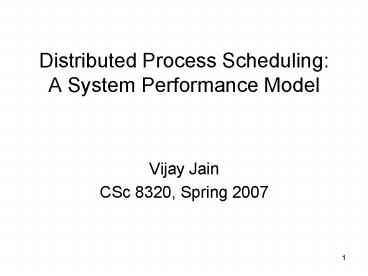Distributed Process Scheduling: A System Performance Model PowerPoint PPT Presentation
1 / 20
Title: Distributed Process Scheduling: A System Performance Model
1
Distributed Process Scheduling A System
Performance Model
- Vijay Jain
- CSc 8320, Spring 2007
2
Outline
- Overview
- Process Interaction Models
- A System Performance Model
- Efficiency Loss
- Processor Pool and Workstation Queuing Models
- Comparison of Performance for Workload Sharing
- References
3
Overview
- Before execution, processes need to be scheduled
and allocated with resources - Objective
- Enhance overall system performance metric
- Process completion time and processor utilization
- In distributed systems location and performance
transparency - In distributed systems
- Local scheduling (on each node) global
scheduling - Communication overhead
- Effect of underlying architecture
4
Process Interaction Models
- Precedence process model Directed Acyclic Graph
(DAG) - Represent precedence relationships between
processes - Minimize total completion time of task
(computation communication) - Communication process model
- Represent the need for communication between
processes
5
Process Interaction Models
- Optimize the total cost of communication and
computation - Disjoint process model
- Processes can run independently and completed in
finite time - Maximize utilization of processors and minimize
turnaround time of processes
6
Process Models
Partition 4 processes onto two nodes
7
System Performance Model
Attempt to minimize the total completion time of
(makespan) of a set of interacting processes
8
System Performance Model (Cont.)
- Related parameters
- OSPT optimal sequential processing time the
best time that can be achieved on a single
processor using the best sequential algorithm - CPT concurrent processing time the actual time
achieved on a n-processor system with the
concurrent algorithm and a specific scheduling
method being considered - OCPTideal optimal concurrent processing time on
an ideal system the best time that can achieved
with the concurrent algorithm being
9
System Performance Model (Cont.)
- considered on an ideal n-processor system (no
interprocessor communication overhead) and
scheduled by an optimal scheduling policy - Si ideal speedup obtained by using a multiple
processor system over the best sequential time - Sd the degradation of the system due to actual
implementation compared to an ideal system
10
System Performance Model (Cont.)
Pi the computation time ofthe concurrent
algorithm onnode i
(RP ? 1)
11
System Performance Model (Cont.)
(The smaller, the better)
12
System Performance Model (Cont.)
- RP Relative processing
- Shows how much loss of speedup is due to the
substitution of the best sequential algorithm by
an algorithm better adapted for concurrent
implementation but which may have a greater total
processing need - Sd
- Degradation of parallelism due to algorithm
implementation
13
System Performance Model (Cont.)
- RC Relative concurrency
- How far from optimal the usage of the n-processor
is - RC1 ? best use of the processors
- ? Efficiency Loss is loss of parallelism when
implemented on a real machine. - ? can be decomposed into two terms
- ? ?sched ?syst
14
Efficiency Loss ?
Impact factors scheduling, system, and
communication
15
Efficiency Loss ? (Cont.)
16
Workload Distribution
- Performance can be further improved by workload
distribution - Load sharing static workload distribution
- Dispatch process to the idle processors
statically upon arrival - Corresponding to processor pool model
- Load balancing dynamic workload distribution
- Migrate processes dynamically from heavily loaded
processors to lightly loaded processors - Corresponding to migration workstation model
17
Workload Distribution
- Performance of systems described as queuing
models can be computed using queuing theory. An
X/Y/c queue is one where - X Arrival Process, Y Service time distribution,
c Numbers of servers - ? arrival rate ? service rate ? migration
rate - ? depends on channel bandwidth, migration
protocol, context and state information of the
process being transferred.
18
Processor-Pool and Workstation Queueing Models
Static Load Sharing
Dynamic Load Balancing
M for Markovian distribution
19
Comparison of Performance for Workload Sharing
(Communication overhead)
(Negligible Communication overhead)
?0 ? M/M/1 ???M/M/2
20
References
- Distributed Operating Systems and Algorithms by
Randy Chow and Theodore Johnson - Opearting System Concepts by Silberschatz,
Galvin and Gagne - Time Comparative Simulator for Distributed
Process Scheduling Algorithms, Transactions on
Engineering, Computing and Technology Volume 13
May 2006 ISSN 1305-5313, Nazleeni Samiha Haron,
Anang Hudaya Muhamad Amin, Mohd Hilmi Hasan,
Izzatdin Abdul Aziz,and Wirdhayu Mohd Wahid

